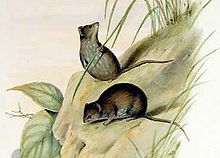Miniature bag mouse
| Miniature bag mouse | ||||||||||||
|---|---|---|---|---|---|---|---|---|---|---|---|---|

Miniature bag mouse ( Planigale maculata ) |
||||||||||||
| Systematics | ||||||||||||
|
||||||||||||
| Scientific name | ||||||||||||
| Planigale maculata | ||||||||||||
| ( Gould , 1851) |
The dwarf pouch mouse ( Planigale maculata ), also known as the coastal flat-head pouch or spotted flat -head pouch , is a very small member of the predator family . It is divided into two subspecies:
- Planigale maculata maculata lives in the east of Australia from the Cape York Peninsula in the north to Gosford in the south and on Bribie and Fraser Island .
- Planigale maculata sinualis occurs in northern Australia and on Groote Eylandt . A population found on Barrow Island could be a previously undescribed species.

features
The dwarf bag mouse has a head-to-trunk length of 5.2 to 8.4 cm, a 4.6 to 6.5 cm long tail and weighs 3.5 to 17.2 g. Their fur is cinnamon to gray and, despite the species name maculata (= spotted), hardly spotted. The dwarf pouch mouse can be distinguished from other small predator mice on the basis of its small size, the conical head, the broad hind feet and the bright claws. The animals have three premolars on each side of the upper and lower jaw.
Habitat and way of life
In their area of distribution, the animals colonize almost all terrestrial habitats, from cool mountain rainforests to floodplains near rivers, and can also be found in weedy urban areas. They are largely nocturnal and spend the day under stones, fallen wood, bark, in termite structures or in hollow objects thrown away by humans. The miniature pouch mouse looks for its food in fallen leaves, in grass or in other low vegetation. It can overwhelm relatively large prey and kills them by biting the neck or the top of the head. Miniature pouch mice kept in captivity ate moths, grasshoppers, ghosts , spiders, small skinks and carrion. In the wild, they also eat small specimens of the cane toad introduced into Australia by humans . Since in most cases they start eating at the head, they do not poison themselves immediately, but only notice when they approach the poison-excreting ear glands that this food is indigestible. After that, they avoid both the cane toad and the native frog for a while. Whether they live alone or in small groups is uncertain.
Reproduction
To reproduce, the animals build an oval nest out of thin grass. The females get 4 to 10 pups per litter, at the top end there are 8 to 12 or 13 pups. In eastern Australia the animals multiply in spring and summer, at the top end they multiply all year round. The young animals stay together in the nest until they weigh 6 g.
Danger
The threat of this species includes the loss of habitat due to the spread of human settlements and the stalking of domestic cats. The IUCN classifies the miniature bag mouse as Least Concern due to its wide distribution . Predators that eat pygmy pouches include domestic cats, dogs, the pygmy marten , barn owl, and larger cane toads.
Individual evidence
- ↑ a b c d Andrew Baker: Family Dasyuridae (Carnivorous Marsupials). Pages 328-329 in Don E. Wilson , Russell A. Mittermeier : Handbook of the Mammals of the World - Volume 5. Monotremes and Marsupials. Lynx Editions, 2015, ISBN 978-84-96553-99-6
- ↑ Planigale maculata in the endangered Red List species the IUCN 2008. Posted by: Burnett, S. & Dickman, C., 2008. Accessed May 25, 2013.
